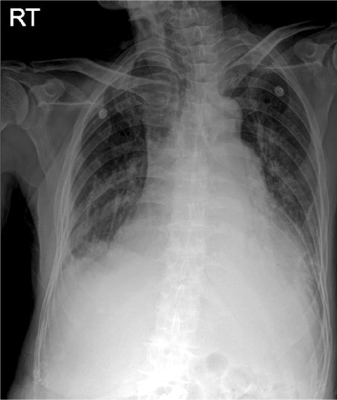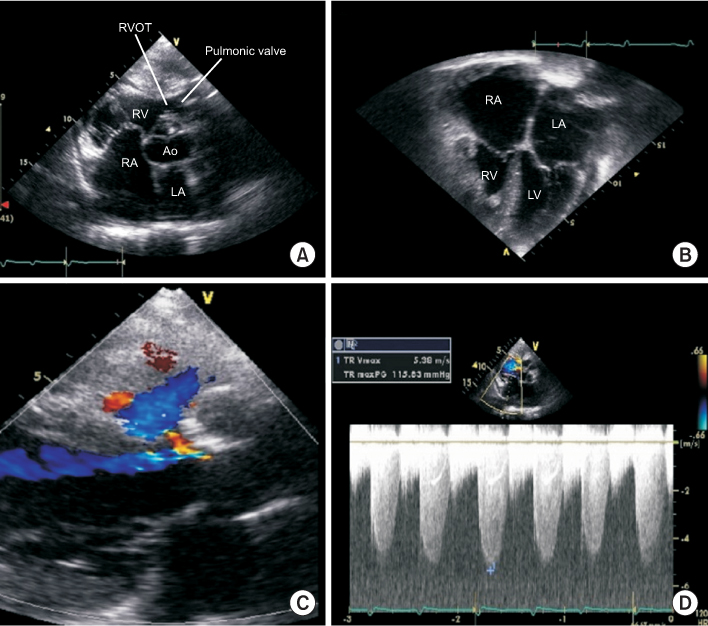Ewha Med J.
2017 Apr;40(2):94-98. 10.12771/emj.2017.40.2.94.
A 75-Year-Old Natural Survivor with Uncorrected Tetralogy of Fallot Presenting with Hypoxic Spell
- Affiliations
-
- 1Department of Pediatrics, Myongji Hospital, Goyang, Korea. hihikwak@hanmail.net
- KMID: 2379505
- DOI: http://doi.org/10.12771/emj.2017.40.2.94
Abstract
- Tetralogy of Fallot (TOF) is the most common cyanotic congenital heart disease. Only a few patients reach adulthood without surgical correction. Unrepaired TOF patients with mild to moderate right ventricular outflow tract (RVOT) obstruction may be clinically silent until adulthood. TOF with hypoxic spells present as periods of profound cyanosis that occur because of almost total RVOT obstruction. So, hypoxic spell typically occurs in a crying infant but is rare in an adult. In this report, we presented a case of a 75-year-old patient with uncorrected TOF presenting with hypoxic spell, consequent pulmonary hypertension and chronic heart failure. This is the oldest case of natural survivor with uncorrected TOF in Korea and the oldest patient presenting hypoxic spell worldwide.
Keyword
MeSH Terms
Figure
Reference
-
1. Hoffman JI. Incidence of congenital heart disease: I. postnatal incidence. Pediatr Cardiol. 1995; 16:103–113.2. Bertranou EG, Blackstone EH, Hazelrig JB, Turner ME, Kirklin JW. Life expectancy without surgery in tetralogy of Fallot. Am J Cardiol. 1978; 42:458–466.3. Iga K, Hori K, Matsumura T, Gen H, Kitaguchi S, Tomonaga G, et al. A case of unusual longevity of tetralogy of Fallot confirmed by cardiac catheterization. Jpn Circ J. 1991; 55:962–965.4. Anders HJ, Fuchshuber S. Bisoprolol treatment for cyanotic spells: a 69-year-old female with uncorrected pentalogy of Fallot. Eur J Med Res. 2001; 28:275–276.5. Taksande A, Gautami V, Padhi S, Bakshi K. Hypercyanotic spells. J Mahatma Gandhi Inst Med Sci. 2009; 14:7–9.6. Perloff JK. The clinical recognition of congenital heart disease. 5th ed. Philadelphia: Saunders;2003.7. Guntheroth WG, Morgan BC, Mullins GL. Physiologic studies of paroxysmal hyperpnea in cyanotic congenital heart disease. Circulation. 1965; 31:70–76.8. Pekdemir H, Gokhan Cin V, Necdet Akkus M, Doven O. Cyanotic tetralogy of Fallot with its infective endocarditis complication on the tricuspid and pulmonary. Circ J. 2004; 68:178–180.9. Yasuhara J, Yamagishi H. Pulmonary arterial hypertension associated with tetralogy of Fallot. Int Heart J. 2015; 56:Suppl. S17–S21.
- Full Text Links
- Actions
-
Cited
- CITED
-
- Close
- Share
- Similar articles
-
- Postoperative Management of Tetralogy of Fallot Japanese Experience Mortality and morbidity in patients with tetralogy of Fallot long after repair: Japanese Multi-center Studies
- A Rare Case of Tetralogy of Fallot Associated with Pulmonary Artery Sling
- Transatrial-transpulmonary repair of tetralogy of Fallot
- Aortic Root and Ascending Aortic Aneurysm in an Adult with a Repaired Tetralogy of Fallot
- Tetralogy of Fallot associated with atrioventricular canal defect: report of one case





